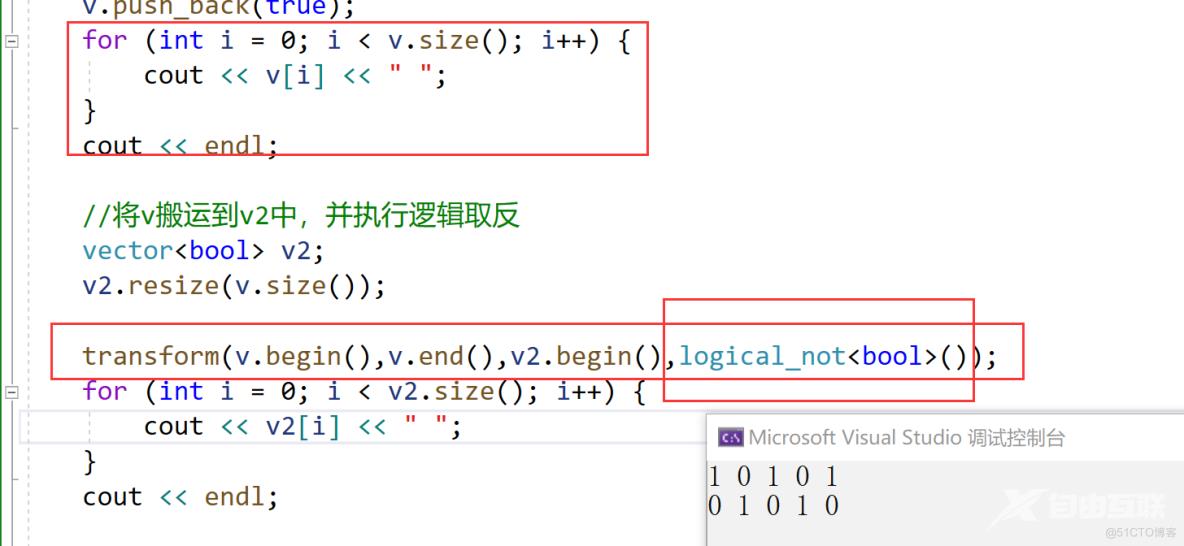1、函数对象 1.1、函数对象概念 概念: 重载函数调用()操作符的类,其对象常称为函数对象 函数对象使用重载的()时,行为类似函数调用,也叫仿函数 本质: 函数对象(仿函数)是一个类
1、函数对象
1.1、函数对象概念
概念:
- 重载函数调用()操作符的类,其对象常称为函数对象
- 函数对象使用重载的()时,行为类似函数调用,也叫仿函数
本质:
函数对象(仿函数)是一个类,不是一个函数
1.2、函数对象的使用
特点:
- 函数对象在使用时,可以像普通函数那样调用, 可以有参数,可以有返回值
- 函数对象超出普通函数的概念,函数对象可以有自己的状态
- 函数对象可以作为参数传递
示例:
//函数对象的特点
class myAdd {
public:
myAdd() {
this->count = 0;
}
int operator()(int a,int b) {
count++;
return a + b;
}
int count;
};
//1、函数对象在使用时,可以像普通函数那样调用, 可以有参数,可以有返回值
void test01() {
myAdd add;
cout <<"test01两数之和:"<< add(1, 2) << endl;
}
//2、函数对象超出普通函数的概念,函数对象可以有自己的状态
void test02() {
myAdd add;
cout << "test02两数之和:" << add(1, 2) << endl;
cout << "test02两数之和:" << add(2, 3) << endl;
cout << "test02两数之和:" << add(3, 4) << endl;
cout << "test02add,调用次数:" << add.count << endl;
}
//3、函数对象可以作为参数传递
void doAdd(myAdd add,int a,int b) {
cout << "test03两数之和:" << add(a,b) << endl;
}
void test03() {
myAdd add;
doAdd(add,5,6);
}
int main() {
test01();
test02();
test03();
system("pause");
return 0;
}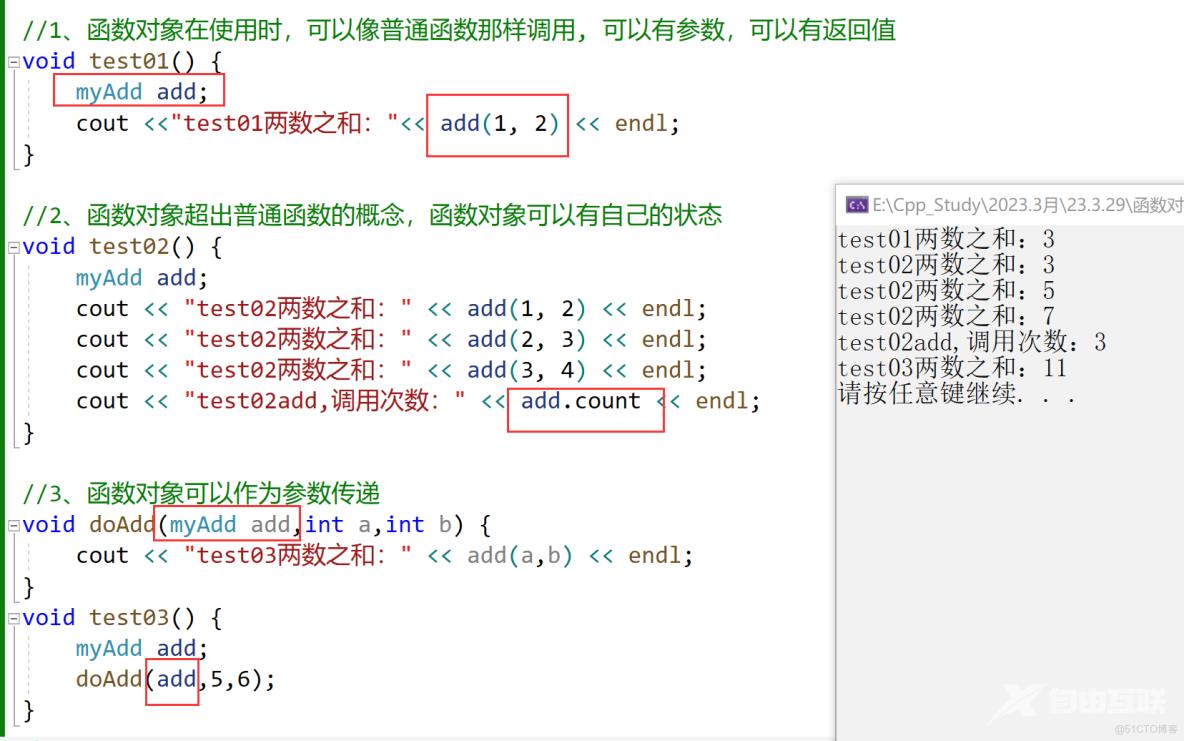
2、谓词
2.1、谓词概念
概念:
- 返回bool类型的仿函数称为谓词
- 如果operator()接受一个参数,那么叫做一元谓词
- 如果operator()接受两个参数,那么叫做二元谓词
2.2、一元谓词
示例:
#include<vector>
#include<algorithm>
//一元谓词
class greaterFive {
public:
bool operator()(int a) {
return a > 5;
}
};
void test01() {
vector<int> v;
for (int i = 0; i < 10;i++) {
v.push_back(i);
}
//greaterFive() 匿名对象
//find_if(),找到返回该位置迭代器,未找到返回end();
vector<int>::iterator it = find_if(v.begin(),v.end(),greaterFive());
if (it == v.end()) {
cout << "未找到" << endl;
}
else {
cout << "找到了,为:" << *it << endl;
}
}
int main() {
test01();
}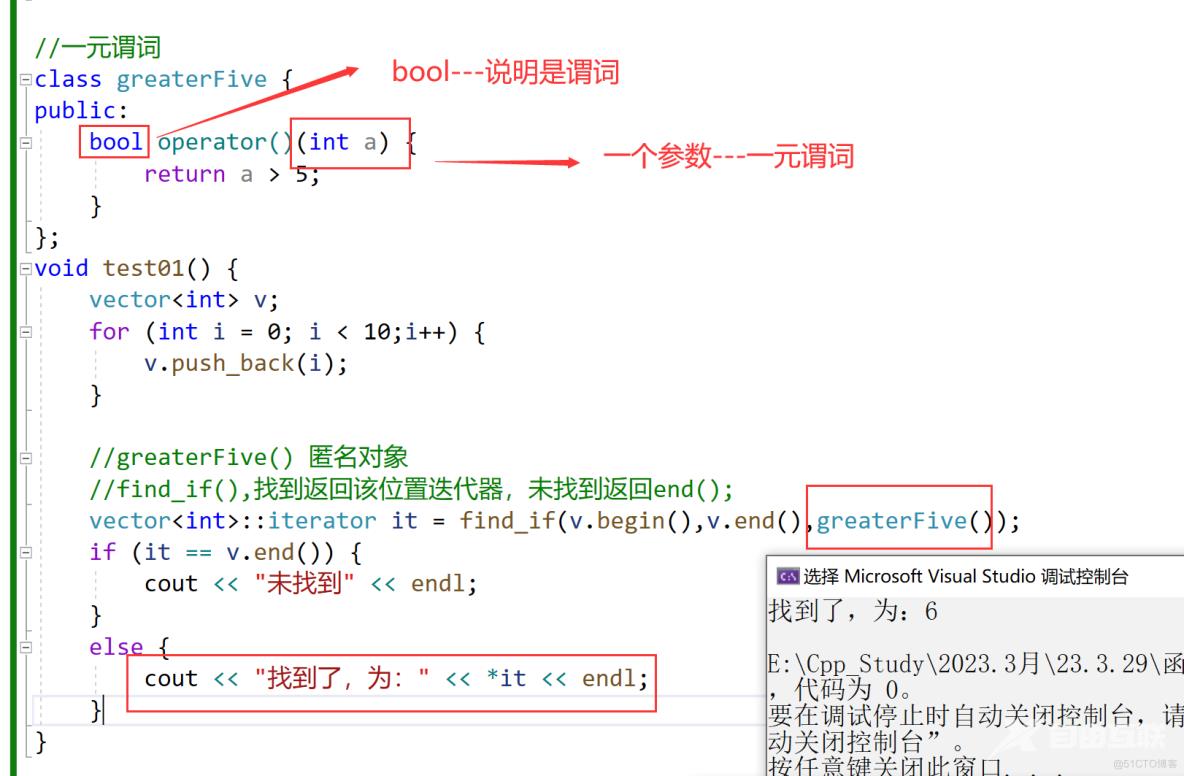
2.3、二元谓词
#include<vector>
#include<algorithm>
//二元谓词
class myCompare {
public:
bool operator()(int a,int b) {
return a > b;
}
};
void test01() {
vector<int> v;
v.push_back(10);
v.push_back(50);
v.push_back(40);
v.push_back(30);
v.push_back(70);
//sort(),默认升序
sort(v.begin(),v.end());
for (int i = 0; i < v.size();i++) {
cout << v[i] << " ";
}
cout << endl;
//利用二元谓词,改变排序规则
sort(v.begin(), v.end(),myCompare());
for (int i = 0; i < v.size(); i++) {
cout << v[i] << " ";
}
cout << endl;
}
int main() {
test01();
system("pause");
}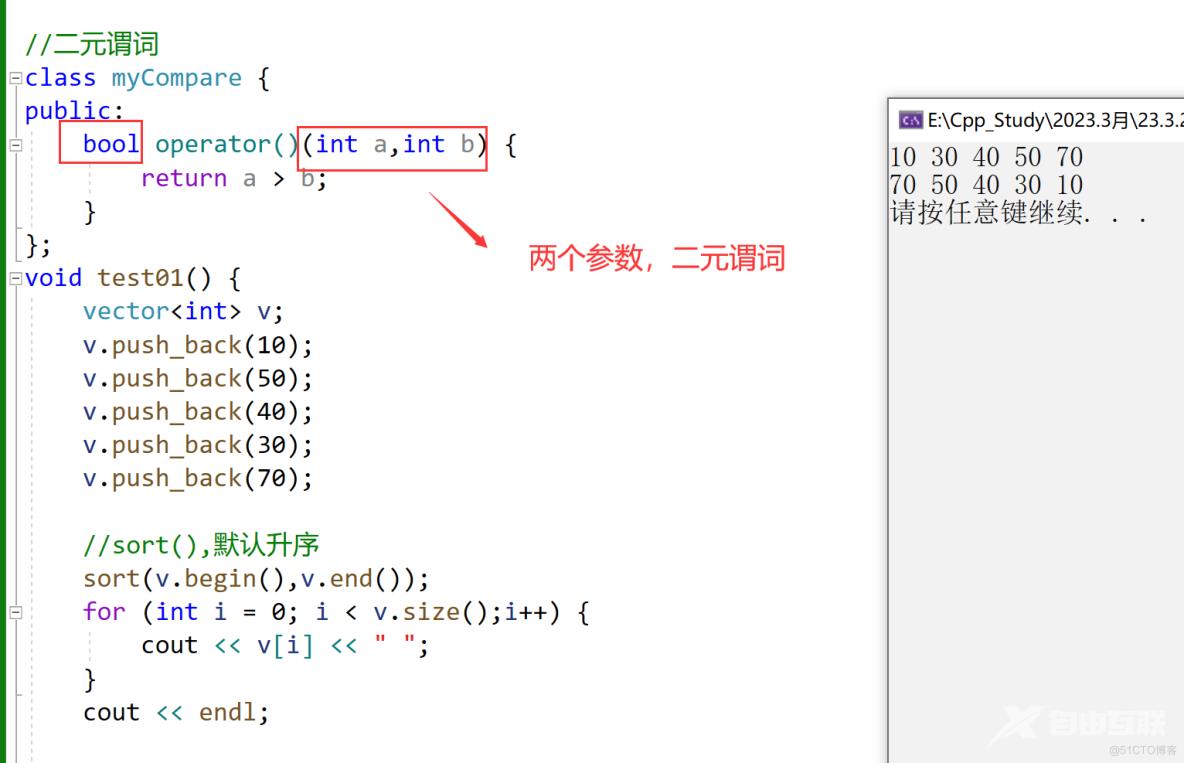
3、内建函数对象
3.1、理解内建函数对象
概念:
- STL内建了一些函数对象
分类:
- 算术仿函数
- 关系仿函数
- 逻辑仿函数
用法:
- 这些仿函数所产生的对象,用法和一般函数完全相同
- 使用内建函数对象,需要引入头文件 #include<functional>
3.2、算术仿函数
功能描述:
- 实现四则运算
- 其中negate是一元运算,其他都是二元运算
仿函数原型:
- template<class T> T plus<T> //加法仿函数
- template<class T> T minus<T> //减法仿函数
- template<class T> T multiplies<T> //乘法仿函数
- template<class T> T divides<T> //除法仿函数
- template<class T> T modulus<T> //取模仿函数
- template<class T> T negate<T> //取反仿函数
示例:
void test01() {
//一元运算 negate
negate<int> n;
int a = 10;
cout << "a取反:" << n(a) << endl;
//二元运算
plus<int> p; //+
cout << "plus:" << p(1,2) << endl;
minus<int> m; //-
cout << "minus:" << m(1, 2) << endl;
multiplies<int> mp; //*
cout << "multiplies:" << mp(1, 2) << endl;
divides<int> d; // /
cout << "divides:" << d(4, 2) << endl;
modulus<int> md;
cout << "modulus:" << md(3, 2) << endl;
}
int main() {
test01();
system("pause");
return 0;
}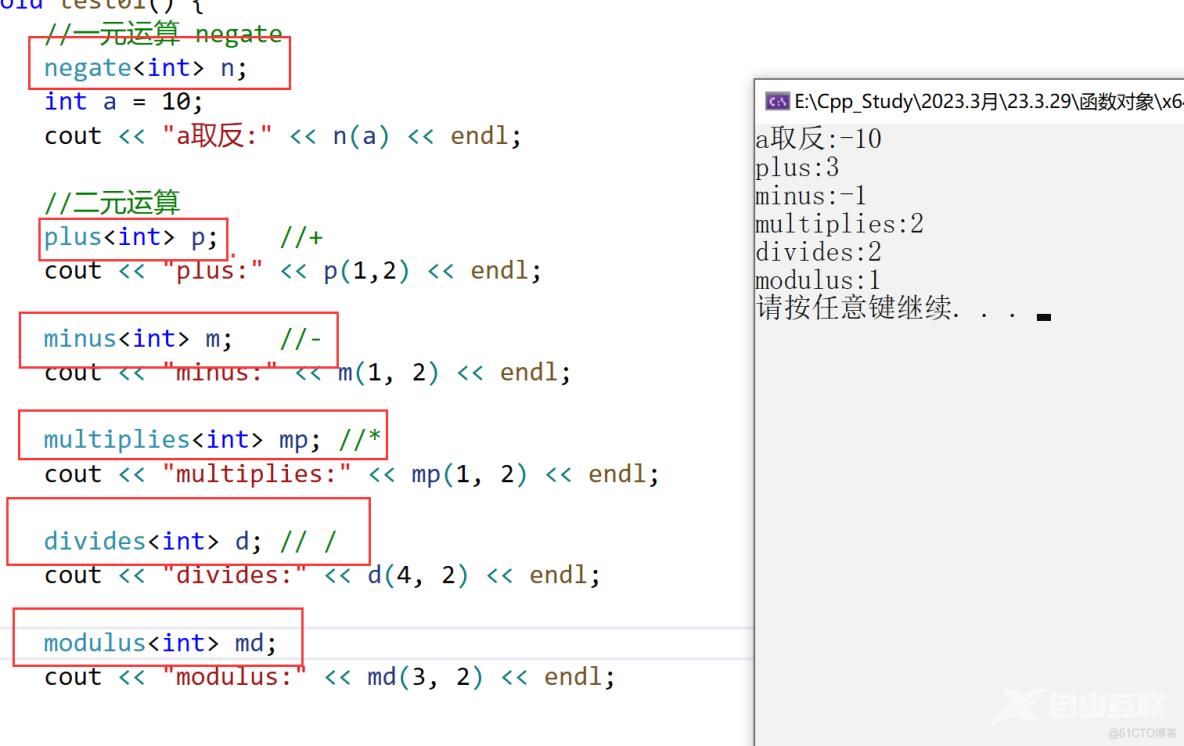
3.3、关系仿函数
功能描述:
- 实现关系对比
仿函数原型:
- template<class T> bool equal_to<T> //等于
- template<class T> bool not_equal_to<T> //不等于
- template<class T> bool greater<T> //大于
- template<class T> bool greater_equal<T> //大于等于
- template<class T> bool less<T> //小于
- template<class T> bool less_equal<T> //小于等于
示例:
//关系仿函数
void test01() {
vector<int> v;
v.push_back(10);
v.push_back(30);
v.push_back(50);
v.push_back(20);
v.push_back(40);
for (int i = 0; i < v.size();i++) {
cout << v[i] << " ";
}
cout << endl;
//默认降序 less<T>()
sort(v.begin(),v.end());
for (int i = 0; i < v.size(); i++) {
cout << v[i] << " ";
}
cout << endl;
//使用greater<T>(),改变规则为升序
sort(v.begin(),v.end(),greater<int>());
for (int i = 0; i < v.size(); i++) {
cout << v[i] << " ";
}
}
int main() {
test01();
}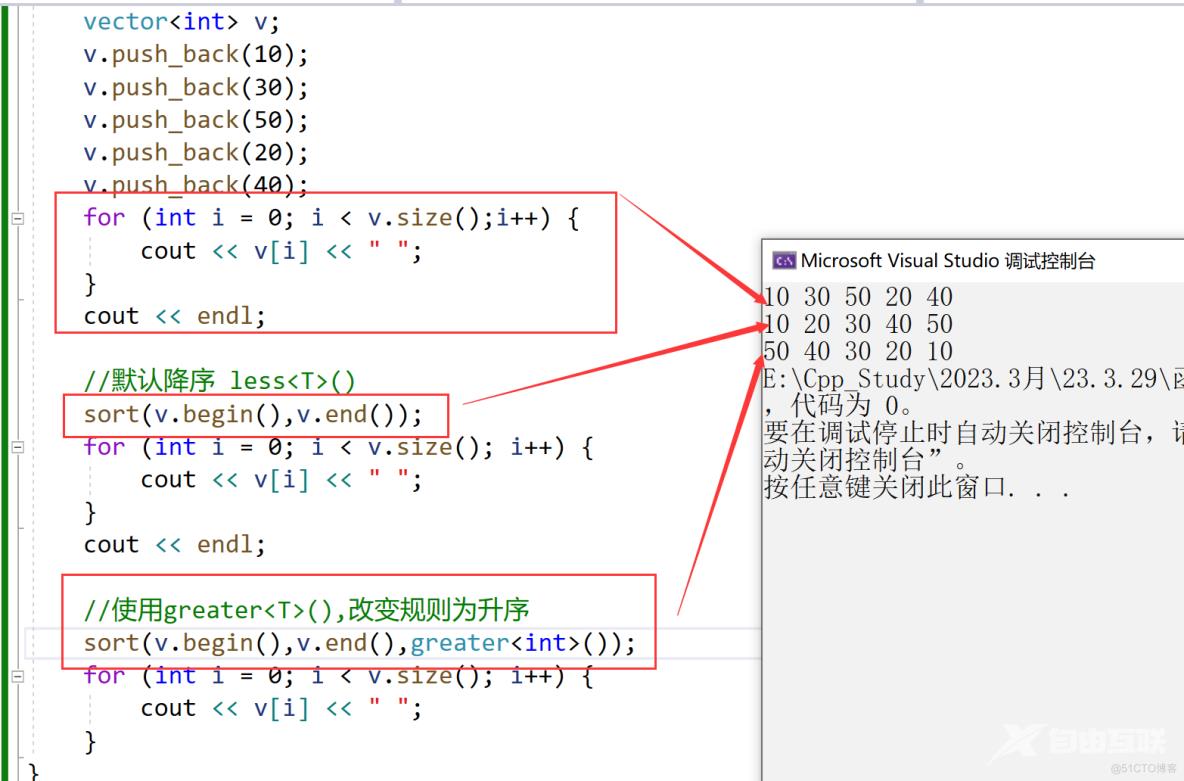
3.4、逻辑仿函数
功能描述:
- 实现逻辑运算
函数原型:
- template<class T> bool logical_and<T> //逻辑与
- template<class T> bool logical_or<T> //逻辑或
- template<class T> bool logical_not<T> //逻辑非
示例:
//逻辑仿函数
void test01() {
vector<bool> v;
v.push_back(true);
v.push_back(false);
v.push_back(true);
v.push_back(false);
v.push_back(true);
for (int i = 0; i < v.size(); i++) {
cout << v[i] << " ";
}
cout << endl;
//将v搬运到v2中,并执行逻辑取反
vector<bool> v2;
v2.resize(v.size());
transform(v.begin(),v.end(),v2.begin(),logical_not<bool>());
for (int i = 0; i < v2.size(); i++) {
cout << v2[i] << " ";
}
cout << endl;
}
int main() {
test01();
}